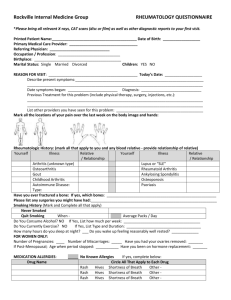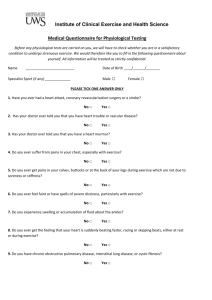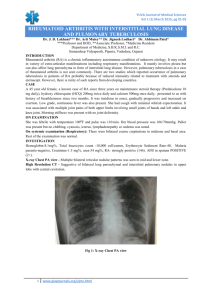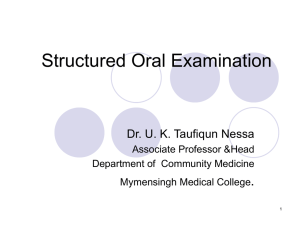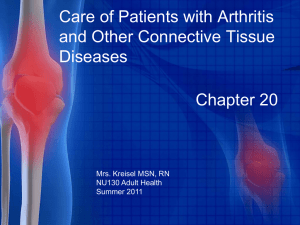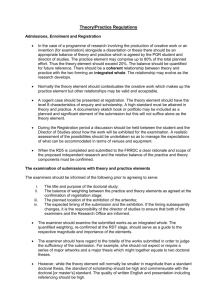Long Case Examinations
advertisement
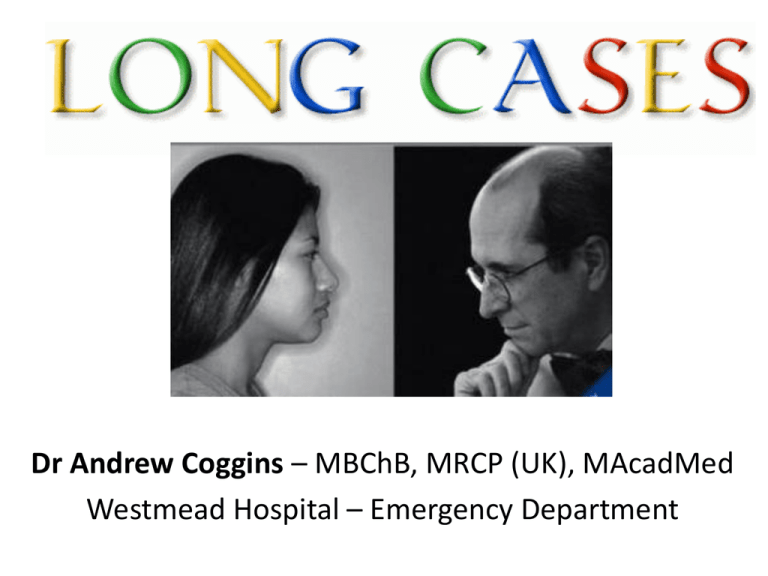
Dr Andrew Coggins – MBChB, MRCP (UK), MAcadMed Westmead Hospital – Emergency Department • Covered in this Talk – General Tips to get through the Long Case – Technique • Getting the information down • Time management – History • Key memory aids and questions – Presentation Technique – Issues List and Management Plan – Organising you plan and discussion – Example Cases • Give the patient TIME – they will tell you their problems and you can write them down • Try various methods of GETTING THE INFORMATION DOWN – i.e. Pens, Paper and various Templates • You have a LONG TIME – use the time wisely • Practice OPENING STATEMENTS and closing statements as much as possible as this is where the money is • Seek FEEDBACK from experienced registrars or consultants • Quality PRACTICE with examiners under actual exam conditions – Do at least 10 good cases under time pressure • You have 60 minutes with the patient and then a variable amount of time (about 10 minutes) to collect you thoughts and finalise your notes outside the room (expect delays) • Use an A3 Manilla folder divided into two A4 pages and quartered to organised you notes • Use the back of the folder at right angles to document your Examination and List Issues • • • • • • Write on One side Divide into Sections History on 2-3 pages Examination on 1 page Summary on 1 page Issues and Management on 1 page • Notepad also works but is small and can take up a lot of pages • Always ask the patient: – What is you major health concern? – And what are you most worried about? (you may be surprised at the answer) • Tell the patient that you are in an exam – and you may need to rush towards the end, however prior to this establish a bit of a rapport • Elicit ICE – ideas, concerns and expectations • Detailed Social History (ABCDEFGHIJK-LMP) • Alcohol • Bonking (i.e. important in male diabetics) • Cigarettes • Driving • Employment • Finances (Social Supports and Benefits) • Family Support / Carers • GHB – And other Illicit Drugs • Hobbies • Immunisations (e.g. Flu and Pneumonia Vac) • Journeys – Travel (especially overseas) • Kangaroos (Pets) • LMP – (12-60F pregnant until proven otherwise) • Collect all you belongings and notes • Examine the patient!!* – Don’t miss Visual Impairment, Walking Sticks and Mobile Oxygen – General Examination for Scars and Classic Signs • Cross-Check - with the patient that you have covered everything • Leave time to ask the following: – Is there something else? – Is there anything else on your mind? – * Is there anything that the examiners felt was important (or were interested in) that I have not covered? • Examiners usually start with pleasantries • They will often check if there were any problems with the patient… • Examiner: – “Did you have any issues with your Patient?” • Student Response: – “There were no major issues, although I had difficulty walking the patient due to their peripheral neuropathy. She was worried because her son, who is her care giver, had to leave half way through to pick up his brother from the airport…” • Opening Statement (Needs to be Snappy): – “Mr Joe Bloggs is a 70 year old Retired Internet Entrepreneur with a Relevant Past Medical History of Valvular Heart Disease, Hypertension and Heavy Smoking. He lives with his wife near the hospital and is functionally independent. He has a recent history of admission for 3 days to hospital with Chest Pain and Shortness of Breath” • Middle – History (5-7 mins) and Examination (2-3 mins) – Avoid Jargon / Abbreviations • Summary (Closing Statement) – Keep Short – (‘Q’ for examiners to wake up) – Student (deep breath, pause, move papers…) – “In Summary, Mr Smith is a 70 year old man with a recent admission for chest pain on the background of Ischaemic Heart Disease and Rheumatoid Arthritis. While his recent admission was for severe chest pain which has created a diagnostic issues, his functional deterioration has also created a significant management issue. His main problem seems to be exertional shortness of breath and as a result difficulty with everyday activities of daily living such as driving and cooking. He also continues to smoke which needs to be addressed given his COPD.” – “In more detail, the (5) issues I would like to address in Mr Smith’s case are as follows…” (BE PREPARED TO DISCUSS ANY OF THE ISSUES) Presentation Template • Examiner: “Ok, can you present you case please?” • This a ‘Q’ for your Opening Silo: • Student Response: – “Yes, Today, I had the pleasure of taking a history and examining Mrs Smith” (Formal Introduction to patient) – “Mrs Smith is a 75 year old who’s a retired factor worker who lives with her son” (Social snapshot) – “She presented to hospital two weeks ago after having a series of falls” (MAIN Complaint) Presentation Template 2 • Student Response: – “Her other major concern included worsening shortness of breath and numbness in the legs which I will cover in detail shortly..” – (Relevant Background) – “Of note, Mrs Smith’s relevant background includes: • Ischaemic heart disease – for 15 years requiring bypass graft in 2001 • Rheumatoid Arthritis – generally well controlled with Hydroxychloriqine” Presentation Template 3 • Student Response: – “She also suffers from Diabetes Mellitus which has been treated with oral hypoglycaemics although I note that in the past her concordance had been poor. This appears to have recently improved due the use of a Webster Pack and help from her son” – “The patient’s Main Concern is the Falls and Leg numbness.” • “IN MORE DETAIL …” - (This is a useful ‘Q’ for moving to the main body of the presentation) • In the Exam patient (usually) have CHRONIC and STABLE conditions with multiple issues • I suggest you use The 3 C’s* for each problem to help with planning presentation and discussion • *Condition, Cause and Complication(s) – Diagnosis of acute problem (Condition) – Identify cause of the principal condition and/or precipitating factors for acute presentations (Cause) – Management of actual or potential complications (Complications) Practice Opening Statements for the Following 2 Cases Mrs Elsie Croft is a 72 year old obese lady with triple-vessel coronary artery disease, multiple coronary risk factors and a recent myocardial infarction (MI) She recently presented for angioplasty and stenting of her coronary lesions. This admission has been complicated by on-going dyspnoea. She also suffers from persisting diarrhoea (?cause), diabetes mellitus (end-organ damage – retinopathy), hypertension, hyperlipidaemia, carcinoid tumour of the lung, asthma, emphysema and intermittent depression related to chronic disease and living alone. •PRACTICE AN OPENING AND CLOSING STATEMENT •WHAT ARE THE ISSUES IN THIS CASE? Mr Jason Kenny is a 65 year old male with severe generalised rheumatoid arthritis presenting with a history of progressive dyspnoea, productive cough and fevers for 1 weeks He has also had weight loss and malaise over the last 3 months He has a background of diabetes mellitus, osteoporosis and chronic airflow limitation (COPD). His independence is severely compromised by poor hand function, limited exercise tolerance despite daily home help services provided for the last 2 years. His current medications include prednisone, celecoxib, methotrexate, metformin, pamidronate, calcium carbonate, calcitriol, salbutamol and ipratropium bromide. •PRACTICE AN OPENING AND CLOSING STATEMENT •WHAT ARE THE ISSUES IN THIS CASE? •WHAT ARE THE POTENTIAL DRUG ISSUES? (NB avoid brand names) Chronic Lung Disease Transplant(s) Scleroderma Diabetes with poor control or complications (e.g. Vision, Renal and Peripheral Vascular) HIV Rheumatoid Arthritis Heart Disease (Recent MI, Heart Failure, Valvular Heart Disease) Chronic Liver Disease (e.g. Hepatitis, Alcohol) Obesity Smoking Depression For Sydney Uni there are 6 domains for marking These include History, Examination, Social, Synthesis and Management

